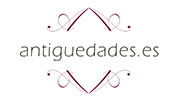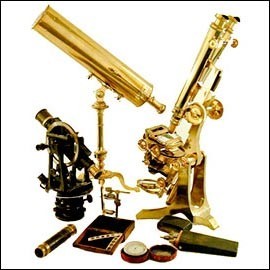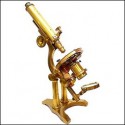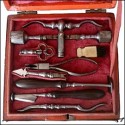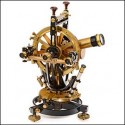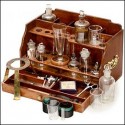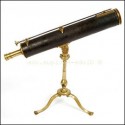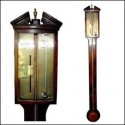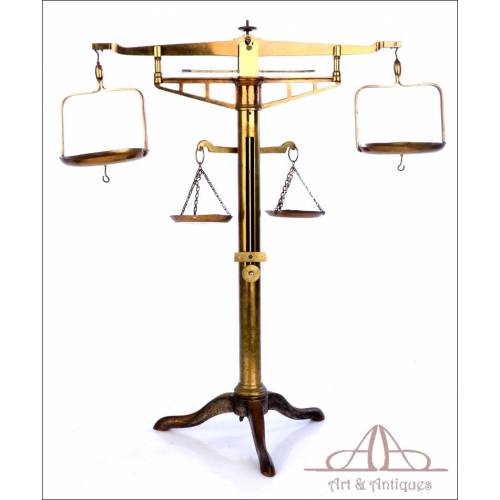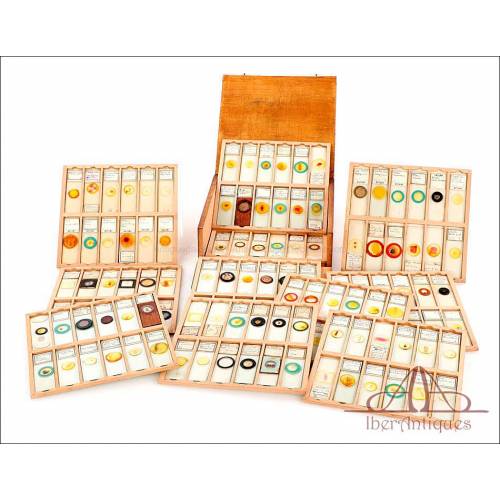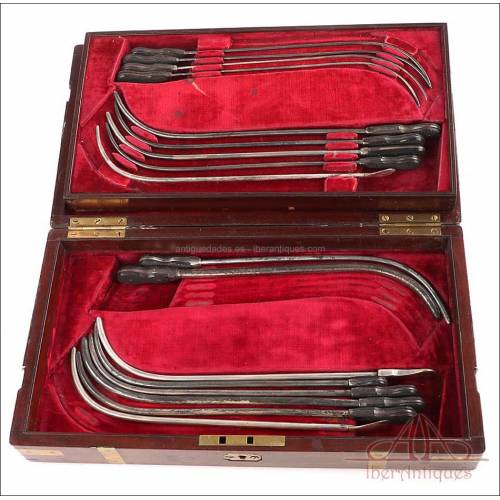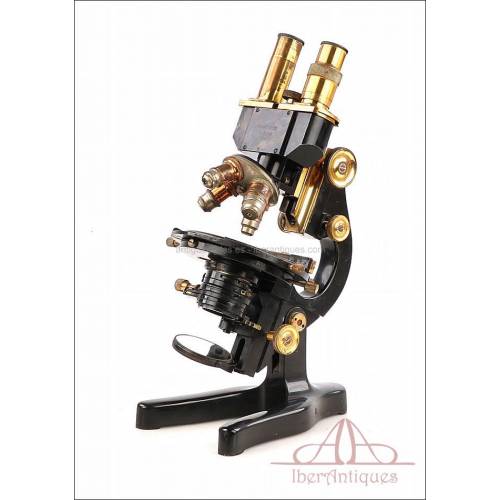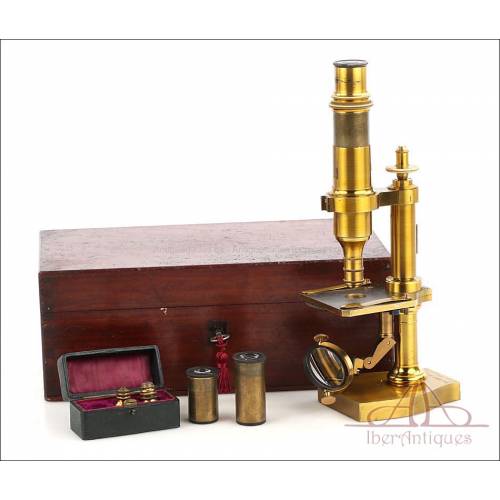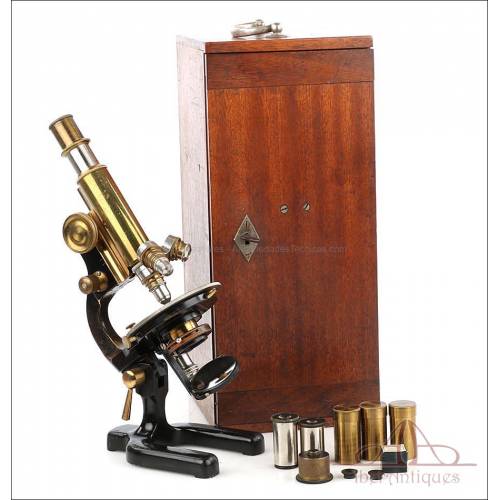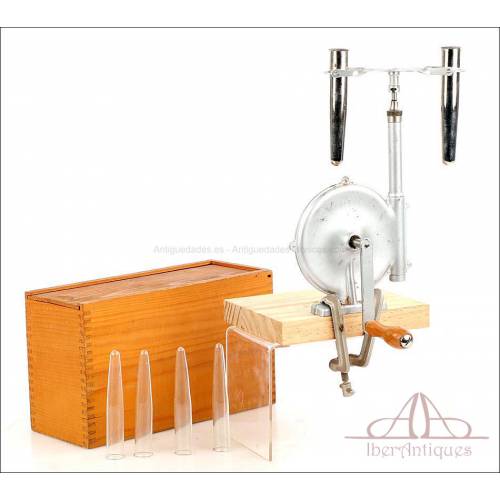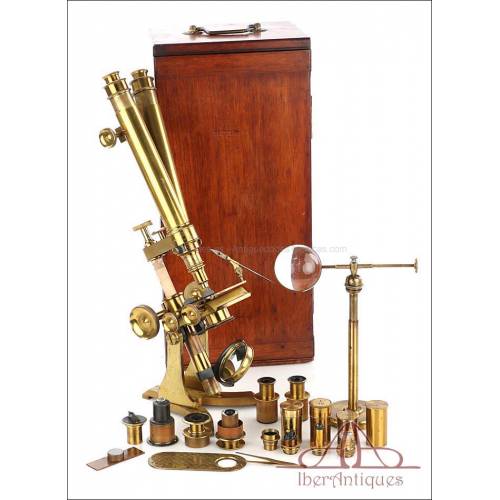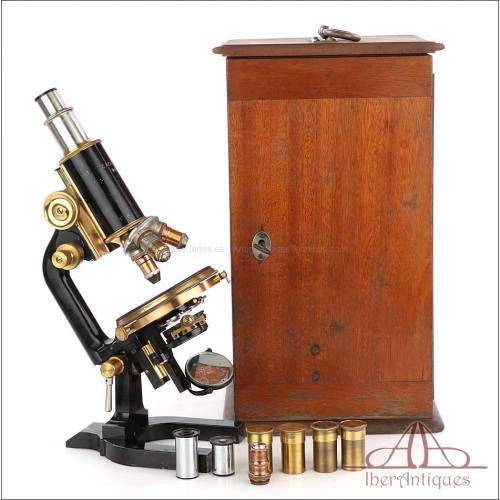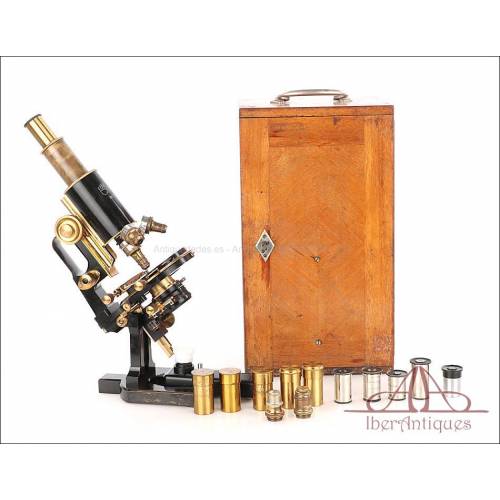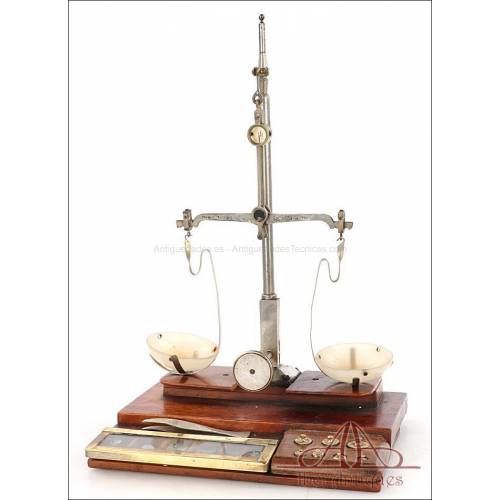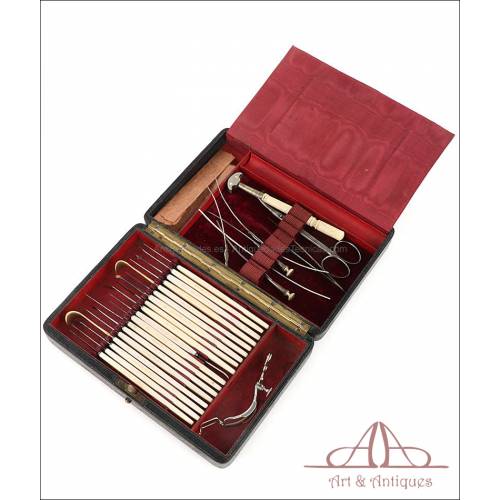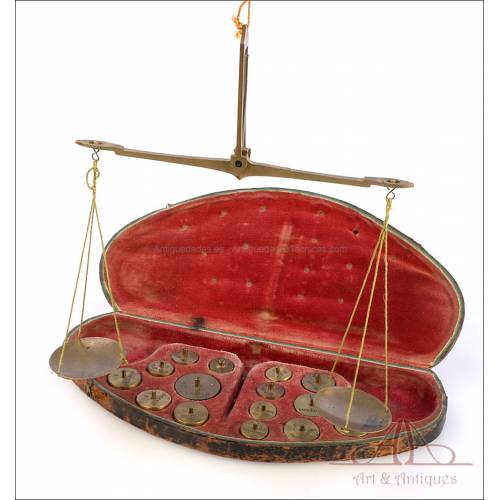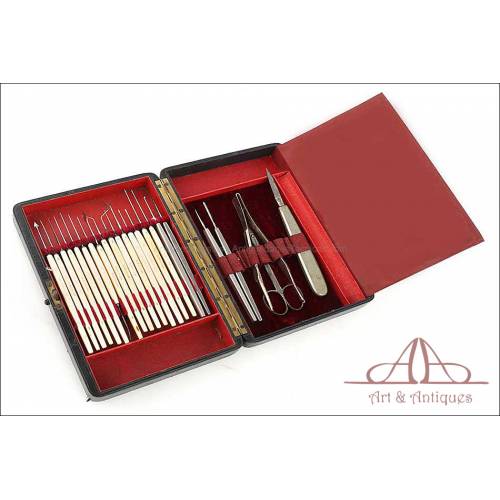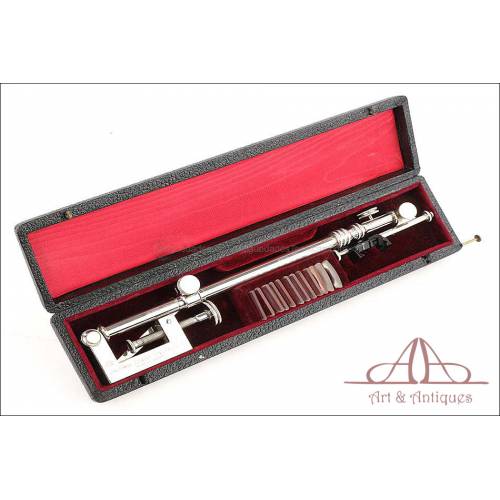Scientific Antiques
The science of our ancestors
Since ancient times, human beings, thanks to their curious nature par excellence, have wondered about the origin of the most insignificant things. The thirst for knowledge gave way, century after century and in different civilizations, to complex studies and trials to test different theories using scientific instrume...
The science of our ancestors
Since ancient times, human beings, thanks to their curious nature par excellence, have wondered about the origin of the most insignificant things. The thirst for knowledge gave way, century after century and in different civilizations, to complex studies and trials to test different theories using scientific instruments and calculations. With the appearance of the scientific method and its popularization by philosophers and scientists, steps were established for the affirmation of different theories: observation, formulation of hypotheses and experimentation. Thanks to the inventiveness of the human being, different study tools were created out of necessity, which facilitated the work of both scientists and teachers. These study instruments are currently classified as precious scientific antiques, witnesses of victories and defeats in the field of scientific study.
If there is one type of fascinating antiques, it is precisely the scientific antiques. Devices enlightened by extraordinary minds that have allowed the development of humanity and have provided us with enviable standards of living. The scientific antiquities are among the most coveted objects by scholars because they help to tell an orderly and coherent story about scientific progress. The objects on display here represent the spearhead of a particular moment in history, as well as shouting out our successes and whispering our mistakes.
The objects on display here represent the spearhead of a particular moment in history.
Antique, unique and functional pieces
For lovers of scientific antiques we have different tools of scientific and educational character from several different eras. These tools are perfect to complete your antiques collection or to satisfy your curiosity as a science lover and learn about the instruments that our ancestors used to immerse yourself in this fascinating world.
The antiques that make up this section
You will be able to find all our scientific antiques classified in different categories in order to find those that interest you the most:
- - Antique microscopes: we have a wide variety of binocular, monocular, drum, dissecting or botanical microscopes among others. In this section you can find pieces of more than 200 years old in perfect condition.
- - Medical and pharmacy antiques: if you are looking for authentic antique pieces of medical instruments, we invite you to check our surgeon's cases, dentist's cases, pharmacy jars, precision scales and trumpets.
- - Surveying and ancient engineering: the first scientific representations of the earth's surface were possible thanks to various measuring instruments such as ancient theodolites, topographic levels or pantographs that, although they may seem rudimentary, have transcended in time to the present day.
- - Laboratory antiques: the tools used in teaching and scientific research have evolved over time. In our store you will find various scientific laboratory antiques such as balances or antique polarimeters among others.
- - Optical antiques: the optical sector offers us really interesting instruments used by navigators or astronomers to carry out their studies or to find the course on a trip. We have several telescopes, spotting scopes, stereoscopes or sextants in perfect condition and fully functional.
- - Other scientific antiques: the most curious and unique pieces of our collection can be found in this section of miscellaneous instruments that have survived for centuries to reach our hands.
Subcategories
Antique Microscopes
Collecting antique microscopes
The human being's thirst for wisdom knows no bounds. Just as he felt the need to observe distant bodies, his infinite curiosity led him to develop the microscope to perceive tiny objects. More than 400 years have passed since the invention of those ancient microscopes.
In the 13th century, the Italian Salvino D'Armato created eyeglasses, but the invention of the microscope is attributed to Zacharias Janssen, an eyeglass maker who, in 1590, created the first compound microscope. In 1665, the English scientist Robert Hooke published "Micrographia" where he described his experience with microscopy. He used the word cells for the first time. Anton van Leeuwenhoek was a Dutch merchant with skills in building microscopes. With them he observed red blood cells and spermatozoa for the first time in 1673. Findings such as this make him the "father of microbiology."The invention spreads around the world
In the 18th and 19th centuries, several firms emerged in Europe and the United States to market this product. Some of them are still in force today. Among the most famous is the Ernst Leitz brand, which became one of the leading optical companies in the 19th century in Germany. It was later renamed Leica. Also in Germany, Carl Zeiss began production in 1847.
The microscopes he invented were very precise and of high quality. Today it is one of the leading companies in microscopy. Carl Friedrich Wilhelm Reichter founded his own company in Vienna in 1876; there he invented a modular and versatile microscope. The French optician Camille Sebastien Nachet designed models that placed great importance on aesthetics. This type of microscope was used by Pasteur and Cajal. Richard Beck's firm was first known as Smith&Beck until his brother James joined.
The English firm built lenses of excellent quality. William Watson founded the company in 1837 in London. His son Thomas extended the business by manufacturing photographic equipment. Thomas Ross was the son of Andrew Ross, a founding member of the Microscope Society in London in 1839. He was one of the top manufacturers in Victorian England. Henry Crouch was one of the top English microscope makers exporting to the United States after an impressive demonstration at a fair in 1876 in Philadelphia. The Bausch &Lomb company was founded in the United States by two German immigrants. They began by manufacturing spectacles. In 1874 they began building compound microscopes.And these are just a few, though perhaps the most famous.
Most common types of antique microscopes
Over the years several types of microscopes were created according to the purpose behind them: mainly there are two main groups, simple microscopes and compound microscopes.
- - The simple microscopes: They use a single lens to magnify the observed samples and the magnification they provide is very limited.
- - The compound microscopes: They use a single lens to magnify the observed samples and the magnification they provide is very limited.
- - The composite microscopes. They have more complex optics because they are made up of multiple lenses. They are used to observe minute details that the human eye is unable to perceive. Among others we can find:
- - Monocular compound microscopes: they only have one tube for one eye. The great discoveries in microbiology were possible thanks to these types of microscopes.
- - Binocular microscopes: they contain two tubes for the eyes, one for each eye. The images they provide are sharper and allow observation for a prolonged time.
- - Binocular microscopes: contain two eye tubes, one for each eye.
- - Drum microscopes: they were designed by Benjamin Martin in the early 18th century. They are composed of a cylinder where the optics are located. They are made of brass although the first ones were made of wood and cardboard.
- - Drum microscopes.
- - Cary Gould type microscopes. Invented in 1820. Its portability made it very popular with naturalists, mineralogists and botanists.
- - Cary Gould type microscope.
- - Botanical microscopess. In the 18th and 19th centuries microscopes became the ideal tool for this guild. They were pocket-sized and had a small box to guard them.
- - Microscopes- Botanical microscopess.
- - Microscopes for dissection. They were patented in the 19th century and were used for what their name indicates.
- - Nuremberg type microscopes. Made of wood, the tube is inserted into a three-legged tripod on whose base is the mirror. They were manufactured in the 18th or early 19th century.
- - Antique petrographic microscopes. They identified crystalline and fibrous substances.
Some of these collector's gems have more than two hundred years behind them and a very special beauty. Antique microscopes are also witnesses to the passage of time and the advancement of mankind. Any collection of microscopes will shine on its own.
Medical and Pharmaceutical Antiques
The history of medicine is the history of mankind. From the beginning, man has created and devised medical instruments to heal and alleviate the illnesses of his fellow man. Ancient Greek and Roman texts already tell us of medical instruments for surgery very similar to those used for centuries to come. Even further back in time, we find evidence of trepanations, some of them successful, in hominid remains found in archaeological sites. Although medical instruments have been perfected thanks to technical advances, it is surprising how the basics retain their original structure.
An exciting collection of medical antiquities
Medical antiques and pharmacy antiques produce an incredible fascination, not only because of their scientific and historical interest but also because they contain the implicit struggle of man against disease. To enter into the collection of medical antiques and pharmacy antiques is to treasure a bit of that mystery. In this section you will find pieces of great quality, beauty and authenticity; an opportunity to start or expand a collection that will last in time; or, to entertain a relative or friend with an elegant and distinguished gift.
Pieces of great quality and beauty
In this section you can find amazing and rare medical and pharmacy antiques in front of which it is impossible not to be amazed as:
All of them are of great quality and beauty.
- Medical instruments such as antique field cases, dating from the nineteenth century with everything needed to perform surgery on the battlefield; instruments for trepanations; autopsy case from the early twentieth century or an electromedical device from 1900 with its control panel and original devices.
- Antiques for pharmacy among which we can find rare and fascinating wooden medicine cabinets from the 19th century, delicate precision scales in perfect use or curious and fascinating bottles from the beginning of the century with pharmaceutical products inside.
- Instruments for dentists such as a curious and elegant cast iron pedal lathe from 1900 or a wooden case with everything necessary for a traveling dentist dating from the early twentieth century.
- Other types of antiques: pieces of great beauty such as an old original Victorian-era press to make pills, interesting and decorative, has its original gears and accessories such as nozzles and plungers. Bleeding instruments such as a 19th century scarifier made in Germany, worthy of being exhibited in a museum.The fascination and the fascination of the world of the pill press are also on display in the museum.
The fascination and interest increases as we go into this tour of medical antiques and antiques pharmacy. An exciting facet of collecting that is a very rewarding investment.
Surveying and Engineering Antiques
Brief history of surveying instruments
Topography, as a science that studies the principles and procedures associated with the graphic representation of the earth's surface, has a history that dates back to ancient times. Already the ancient Romans, in order to build their canals and aqueducts, used topographic devices for leveling, such as the so-called dioptra, a leveling instrument predecessor of today's theodolite. The first square was also built by the Roman engineer Vitruvius, using the fundamentals of the Pythagorean theorem. Later, the Arab civilization developed the astrolabe, while the use of the compass spread.
Between the end of the 16th century and the beginning of the 17th century, important advances took place, such as the introduction of the theodolite-compass or the appearance of the surveyor's chain, until in 1720 the first proper theodolite, which had four leveling screws, was perfected by Jonathan Sisson. These ancient theodolites coincided with the appearance of the first goniometers in the 18th century. In the 19th century the split-image rangefinders appeared and at the beginning of the 20th century the invar stay or horizontal sight. In 1936, the first distance meter was manufactured in the former Soviet Union, and throughout the 20th century it evolved into the microwave and laser distance meters. Thus, a large part of the antique surveying equipment that can be found today comes precisely from the 18th, 19th and 20th centuries.
Topographic antiques for collection
Surveyors and other construction professionals (engineers, architects, quantity surveyors...), as well as all those who wish to start or expand a collection on topographic antiques, antique topographic levels or antique engineering apparatus, should not miss this fascinating section on Topographic and Engineering Antiques, where you will find all kinds of antiques related to surveying and engineering of any branch. These are antique topographic devices that are in perfect state of conservation and operation, preserving all their original period parts in optimal conditions of use.
Main antique topographical instruments
In this fascinating section, interested parties will be able to find any kind of antique topographic apparatus, highlighting among others the following:
- Antique theodolites. They are measuring instruments of mechanical-optical nature with which to measure various types of angles (vertical and horizontal) with high precision.
- Antique theodolites.
- Ancient topographic levels. Their main purpose is to measure unevenness between points located at different heights.
- Ancient topographic gauges. It is an instrument used for the measurement of angles in surveying works.
- Antique pantographs. Mostly used for copying, enlarging or reducing drawings mechanically.
- Antique inclinometers. Used to measure the inclination of a plane with respect to the earth's surface.
.
Laboratory Antiques
From Alchemy to Physics
Alchemy, today regarded as a pseudo-scientific practice, is considered a precursor of modern science, both in terms of the procedures and the instruments used. Its presence extends over 2,500 years, from ancient Mesopotamia to 18th-century Europe, when it was disqualified as a science. A century earlier, in the 17th century, with Galileo Galilei, modern science had been born and the laboratory instruments that were to serve the purposes of the scientific method had begun to be invented with the telescope and the binoculars.
Galileo, under Copernican inspiration, strengthened the practice of experimentation in science by collecting, measuring, observing, comparing and verifying variables and hypotheses. Francis Bacon and Johannes Kepler had pointed the way.
From inventions to antiquities
With the invention of the spectroscope in the early 19th century, Fraunhofer took the decisive step toward measuring the wavelength of light. The old spectroscope was used only to observe a spectrum. With the modern one, the spectrum to be observed is obtained. Other than that, there is no difference between the ancient spectroscope and today's spectroscope.
Still in the field of research on light, thanks to the invention of prisms by William Nicol was invented, still in the nineteenth century, the polarimeter, which uses polarized light to measure the rotational power of bodies. Unlike the old polarimeter, which was operated manually, today's polarimeter is capable of automatic measurements. The old polarimeter required manipulation time; today's polarimeter gives results in a second, thanks to the development of electricity and computer technologies.
The saccharimeter, another 19th century invention, shows the interest of physics in the search for precision. This apparatus, by which the proportion of sugar contained in a liquid is determined, reveals the service of science to industry. The sugar trade underwent an enormous expansion during this century. Also used in oenology, this Irish measuring instrument evolved from optical to digital use.
Intrinsic value of antiques
Link between History and Science, laboratory instruments are a sample of human creativity and ingenuity. The simplicity of the principles on which their invention is based and the magnitude of the results are surprising. The simple barometer invented by Torricelli in the mid-seventeenth century measured atmospheric pressure for the first time.
Over time, if they prevail, instruments so useful to human beings naturally become laboratory antiques and acquire a different value. They are now Antiques. Precious pieces for the collector, for the science lover and observer of history.
Precious pieces for the collector, for the science lover and observer of history.
Silent protagonists of their time, here are these laboratory antiques turned into witnesses, also silent, of other times that somehow were forged with their help. Hence the stimulus to acquire these pieces.
In addition to antique spectroscopes, antique polarimeters and antique saccharimeters, collectors who visit this page in search of laboratory antiques value apparatus for physical demonstrations and other apparatus for experimentation and science teaching. And, of course, the indispensable laboratory equipment, such as test tubes, test tubes, alcoholmeters, hydrometers, balances, beakers and others.
And, of course, the indispensable laboratory equipment, such as test tubes, test tubes, alcoholmeters, hydrometers, balances, beakers and others.
Optical Antiques
Brief history of optical instruments
While there is abundant evidence that optical instruments were already in use in the ancient world, such as the famous 5000-year-old rock crystal lens of Pharaoh Semempses, the first modern lens dates back to the 16th century, when the German Lippershey attempted to patent his crystals. From this point on, Galileo perfected the invention by creating telescopes of up to 30x magnification. The first microscope and the first sliding tube spyglasses also date from this creative period. Soon after came the eyeglasses as we know them, contact lenses and the stereoscope, progress that left behind a series of optical antiquities of great historical value.
Variety in optical antiques
If you are a lover of antiques, and in particular of antique optical instruments, in this section you will find that antique telescope you have always wanted and which may be the ideal specimen to start your collection of optical antiques. You will also find antique marine or field spyglasses, antique magnifying glasses and the rarest stereoscopes you can imagine.
All of these antique optical instruments are available in this section.
Pieces that you can discover in this section
- - Antique telescopes: one of the most precious among optical antiques, here you can find antique pieces dated between the 18th and early 20th century, models that preserve their original components, for mantel, detachable, with tripod and original wooden cases.
- - Antique telescopes: one of the most precious among optical antiques, here you can find antique pieces dated between the 18th and early 20th century, models that preserve their original components, for mantel, detachable, with tripod and original wooden cases.
- - Lens cases for ophthalmologist and ophthalmologic devices: as the manufacturing of ophthalmologic devices developed, the need arose to create special cases for them. Here you will find antique cases where optical professionals kept all types of lenses, in addition to their surgical instruments.
- - Antique spyglasses and binoculars: we have both marine and field glasses and binoculars, dating from the nineteenth and early twentieth century. You can find well-known brands such as William Harris & Son or J. H. Steward, with four or five bodies, with or without tripod; indispensable pieces to build your collection of antique optical instruments.
- - Sextants and octants: these navigational instruments allow you to measure the height of the stars in relation to the sea horizon. Here you can find precious pieces from the early 19th century and mid-20th century.
- - Antique stereoscopes and stereoviewers: also known as "stereoscopic viewers", we have pieces from the early twentieth century, both magnetic and automatic, from prestigious brands such as Educa, Planox, Le Multiphote, French-made, all very well preserved and with lenses of the time.
Other Scientific Antiques
The scientific antiques hide within them all the passion for knowledge of the human being, as well as his incredible ingenuity when trying to cover it. Within this field we can find all kinds of pieces: from fascinating microscopes to laboratory equipment, as well as magnificent engineering instruments. But it is the most curious and special scientific antiques that often arouse greater admiration. Antique barometers, vintage thermographs, rare barographs, curious anemometers and nautical instruments with mysterious voyages behind them make up a very special universe, worthy of the best science and adventure novels.
Ancient barometers and antique barographs
The ingenuity of the inventors of the second half of the 19th century is displayed in the antique barometers and antique barographs present in our collections. The barometer is an element that measures atmospheric pressure; it is part of the mechanism of the barograph, an instrument that reflects such measurements on paper coils, from which data are obtained to make atmospheric predictions. Ancient barometers work according to the mechanism invented by Evangelista Torricelli in 1643, although the definitive name of these instruments was given to them by Edme Mariote twenty-three years later. As for the antique barographs, their mechanism is based on the system designed by Alexander Cumming around 1760. With this instrument, Cunning claimed to make the first record in history by using an aneroid cell.
Antique anemometers
Other scientific antiquesthat arouse our curiosity are antique anemometers. These fascinating instruments, fundamental in meteorology, are responsible for measuring wind speed. Apparently, the first anemometers were invented by the Mayan civilization (1200-1400 BC), where signs of the use of similar instruments have been found. But it was not until 1450 that the first anemometer as we know it was built. It was designed by Leon Battista Alberti, a humanist of reference and an essential figure of the Italian Renaissance. The antique anemometers that can be found today in the best collections are made according to their original design: a disk with a movable pendulum that oscillated driven by the wind, with a scale that marked its intensity. Today, it is possible to admire antique anemometers manufactured in the 19th century or early 20th century, with more complex mechanisms that combine a system of cups or blades with a dial or numbered dial.
Antique compasses
Antique compassesare highly sought after pieces by lovers of nautical antiques. The beauty of the polished brass, the magical precision of their mechanisms and their turn-of-the-century aesthetics transport us to times gone by, when ship voyages lasted months... The first compasses are believed to have been invented in China in the 9th century: their mechanism, a needle floating on a vessel filled with water, is similar to that of most antique compasses preserved today. However, there are voices suggesting that they could have been invented independently in Europe as well: interestingly, the needle of ancient Chinese compasses pointed south, while ancient European compasses always point north. The invention of the compass was an enormous advance, especially for maritime navigation, which until then was guided by the position of the celestial bodies.
Our collection of scientific antiquities is not only limited to these magnificent instruments. It is also possible to find antique thermographs, curious sundials more than a century old, collections of samples or specimens for microscopes that were part of period laboratories... All the knowledge of the scientists of past times, condensed in the most attractive and ingenious devices of antiquity.
Antique Commerce Scale. Circa 1900 Antique Commerce Scale. Circa 1900
Gorgeous antique commerce scale in fine condition. More than one hundred years old. A very decorative piece. Gorgeous antique commerce scale in...
SoldGreat Collection of 144 Antique Microscope Slides. England, 19th Century Great Collection of 144 Antique...
Amazing collection of 144 microscope samples in good condition. In its original wooden case. Collectors piece. Amazing collection of 144 microscope...
SoldAntique Benique Dilator Set in Mahogany Case, 19th Century Antique Benique Dilator Set in...
Antique set of Benique dilators in mahogany and brass case. A historical and collectible medical tool. Antique set of Benique dilators in...
370,00 €Antique Binocular Microscope Leitz Wetzlar from 1930. Germany. Antique Binocular Microscope...
Antique Leitz Wetzlar binocular microscope, rare 1930 model. Precise adjustments and clear vision, ideal for collectors and enthusiasts of scientific instruments. Antique Leitz Wetzlar binocular...
SoldAntique Nachet Brass Microscope Mod. 11. France, Circa 1890 Antique Nachet Brass Microscope...
Fine Nachet 11 microscope in very good condition. Original mahogany case. In great working order. Fine Nachet 11 microscope in very...
SoldAntique Seibert Wetzlar Monocular Microscope. Germany, Circa 1920 Antique Seibert Wetzlar...
Outstanding Seibert Wetzlar Monocular microscope in excellent working order. With wooden case, objectives and eyepieces. Outstanding Seibert Wetzlar Monocular...
SoldAntique Mechanical Laboratory Centrifuge. 1950s-60s Antique Mechanical Laboratory...
Fascinating mid 20th century mechanical laboratory centrifuge. Works very well. Includes 4 vintage test tubes. Fascinating mid 20th century...
SoldExtraordinary Antique Binocular Microscope. Super Complete. England, Circa 1880 Extraordinary Antique Binocular...
Exceptional binocular microscope with storing case and accessories. Very clear vision. Museums piece. Exceptional binocular microscope with...
SoldAntique Reichert Monocular Microscope. Vienna, circa 1920 Antique Reichert Monocular...
Big C. Reichert microscope from the early 20th century, with accessory set. Double shutter. In its original case. Big C. Reichert microscope from the...
SoldAntique Carl Zeiss Jena Jug-Handle Microscope. Germany, Circa 1920 Antique Carl Zeiss Jena...
Amazing jug-handle microscope by Carl Zeiss Jena. In excellent condition and with a complete accessory set. Original case and key. Amazing jug-handle microscope by Carl...
SoldBeautiful Antique Laboratory or Pharmacy Scale. Germany, 1940. Beautiful Antique Laboratory or...
Gorgeous German precision scale from the 1940s. In very good working order. With weigh and micro-weigh sets. Gorgeous German precision scale from...
SoldAntique Charriere Collin Ophthalmological Surgery Set. Complete. France, Circa 1900 Antique Charriere Collin...
Complete antique ophthalmological surgery set made by Charriere Collin. Tools marked with the manufacturers name. In very good condition. Complete antique ophthalmological...
SoldAntique Gold-Coin Scales. France, Circa 1800 Antique Gold-Coin Scales....
Wonderful antique scales for weighing gold coins. With complete weigh set and storing case. Entirely original. Wonderful antique scales for weighing...
290,00 € 370,00 €Antique Charriere Collin Ophthalmological Surgery Set. France, Circa 1900 Antique Charriere Collin...
Beautiful ophthalmological surgery set, nearly one century old. Complete and in fine condition. Beautiful ophthalmological surgery...
SoldAntique Berville Universal Camera Lucida. France, Early 20th Century Antique Berville Universal...
Striking and complete Berville universal camera lucida. In its original storing case. With a complete set of lenses in use condition. Striking and complete Berville...
Sold
New products
-

Antique ivory and silver plated stethoscope, late 19th century
Antique stethoscope from the late 19th century in silver-plated metal...
-

Vintage pendant with shell cameo of Jesús del Gran Poder, carved c. 1970
Vintage pendant with a shell-carved cameo of Jesus del Gran Poder, circa...
-

Antique Roman Style Gilded Silver Chalice with Paten. France, 1932
Antique Roman-style chalice in gilded silver with paten. France, 1932....
-

Beautiful Antique 18 K Gold Ring with 7 Natural Diamonds
Antique 18K gold ring with 7 natural diamonds. Delicate openwork design,...
-

Antique Silver Reliquary. José Vilaplana. Valencia, Spain. Circa 1920
Impressive repoussé silver reliquary by José Vilaplana, Valencia, c....
-

Vintage 18K Gold Ring with 7 Natural Diamonds
Vintage 18K gold ring with seven natural diamonds in floral setting....
-

Antique Silver Chalice. Enameled Crosses. Valencia, Spain, 1942
Spanish chalice from 1942 in solid silver, gifted by the Church of...
-

Antique Silver Chalice and Paten. Granada Spain, circa 1900
Spanish chalice in white silver with matching paten, handcrafted....
Specials
-

Patek Philippe Gents' Wristwatch Ref. 3543. 18K Gold. Switzerland, 1967
Striking gold Patek Philippe gents...
